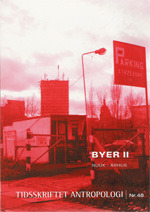SKOPJE
DOI:
https://doi.org/10.7146/ta.v0i48.107093Abstract
The article explores some of the ways in
which the citizens and officials of the
Republic of Macedonia commemorated on
July 26, 2003 the 40th anniversary of the
earthquake that destroyed much of Skopje,
the capital city of the Republic. The fragile
Republic in the center of the Balkans also
commemorated during the same week the
100th anniversary of the failed Ilinden
uprising against Ottoman Turkish rule,
August 2, 1903. The study aims at connecting
diverse expressions of how a
particular society remembers its disasters
and attempts to turn them towards redemption.
The Macedonian sociologist,
Ilja Acheski, used the term “permanent
earthquake” to describe the social fragmentation
of his city in the aftermath of
the 1963 earthquake. The article represents
an extensive commentary on this
theme. One of the characteristic responses
during the earthquake memorial was
nostalgic, perhaps “Jugonostalgic”. Several
people stressed to the ethnographer
how the world society – in the midst of
the Cold War – cooperated to help Skopje
during its moment of need. At the unveiling
of a monumental sculpture of a
suffering woman, who is meant to symbolize
Skopje, an older man told me how
America and Russia joined to help Skopje
in 1963. The commemoration of Skopje’s
earthquake, therefore, made it possible to
acknowledge once again the personal
leadership of Tito for his “Brotherhood
and Unity” policy and for his skill at
uniting East and West. Most of the article,
however, does not dwell on the site of the
monument. The author takes long walks
in Topaana, a Roma “slum”, Cair, a neighboring
Albanian “village”, and Lisece, a
Macedonian “barracks” suburb. This last
named site is one of the working-class
suburbs where the wooden frame houses
were built as contributions from abroad
to rehouse the victims made homeless by
the earthquake.
Downloads
Published
How to Cite
Issue
Section
License
Ophavsretten til artiklerne i Tidsskriftet Antropologi tilfalder forfatteren.
Artikler publiceret i Tidsskriftet Antropologi må citeres, downloades og videresendes for ikke-kommerciel brug, under forudsætning af normal akademisk reference til forfatter(e) samt tidsskrift, årgang, nummer og sider. Artiklerne må kun genudgives med eksplicit tilladelse fra forfatter(e) og tidsskriftet.


